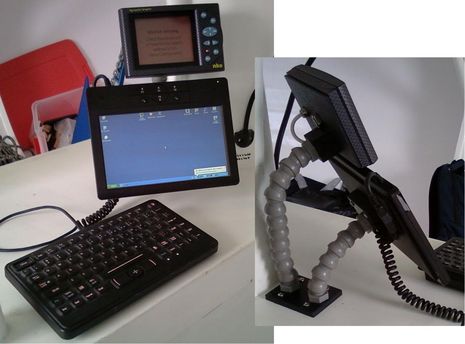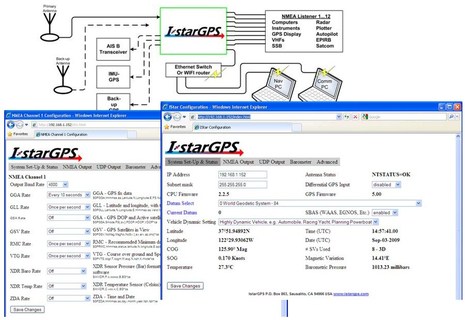Low power PCs #1, & Farallon Electronics
I’ve been trying to search out a low-power 12v PC for Gizmo, though I might give up for this season — I’m so behind project-wise — and it may not be such an issue once I install a decent solar panel or two. But it’s certainly a dynamic subject, and one way to keep up is to watch the folks who are truly obsessed with power efficiency (and low weight)…offshore racing sailors. The photos of that unusual PC in the spartan interior of an Open 40 above were sent along by system designer Eric Steinberg, founder of Farallon Electronics, along with a few details…
The netbook level PC, for instance, is self contained in that 10.1-inch touchscreen LCD, was sourced from Winmate, and is at least very similar to this 12 watt model. Eric says that, while it’s not waterproof, they think it will hold up, and it’s easily replaced. Meanwhile the Cherry keyboard is washable, and features a lock down Clean key and adjustable red backlighting, though Eric is “not at all happy with its HulaPoint mouse.” And finally there are those nifty mounts custom built using Snap-Loc hosing bits, and similar to ones we once spied out on Gitana Eighty.
I first heard about Sausalito-based Farallon Electronics years ago, primarily as specialists in offshore communications and a major distributor of Pactor modems. But these days Steinberg and crew are also involved in developing and manufacturing marine electronics for high performance racing. First up is the precision IstarGPS sensor, which claims to use an unusual Doppler technique called MotionSense to provide “extraordinarily
responsive” SOG and COG. Farallon will also soon be shipping the UltraWhip ultralight VHF antenna…like a 15 ounces light, with 55 feet of coax!
Farallon was also the team that installed the unusual electronics on the (ultra low performance) Plastiki, but when we traded emails this morning, Eric was in Newport on the deck of the super maxi Speedboat, another Farallon project and the inspiration for the IstarGPS. I’d sure like to see how she’s set up electronically to go for Bermuda race line honors again, but such setups don’t seem to get photographed (or even talked about) much. Best I could find is some Sailing Anarchy video glimpses, but what a boat.















Fun. I checked to see if Speedboat was visible via AIS in Newport, and she just got underway. Hopefully they’ll go outside and let er rip.
http://ais1.siitech.com/VTS/AView.aspx
I found these little guys and have actually installed a couple on sailboats. They are Atom based, fanless and have built-in wifi, ethernet, 6 usb ports, only draw about 10watts at 12v and are 4in square by 1in thick. They take standard 2.5in SATA notebook hard-drives – I installed solid state drives in the units I deployed. They run XP, Win7 or linux. The only downsides are that they run a little hot and the video output is digital only, so you can’t connect to a monitor that doesn’t have DVI in.
http://www.amazon.com/CompuLab-fit-PC2-Atom-Z530-Windows/dp/B003KJBNAY/ref=pd_cp_pc_2
http://www.compulab.co.il/fitpc2/html/fitpc2-datasheet.htm
Thanks, Tyler! What sort of software did you install and how well did it perform? The FitPC2 is really attractive but some people seem to think that the Z530 doesn’t have enough moxie for programs like Coastal Explorer. I also asked MaxSea to look at the graphic specs and they are leery that MSTZ can run decently on it.
I was lucky enough to score a Datalux iPix on Ebay for $90.00 – it makes an awesome boat computer, and I would recommend one to others. You can read more on their website: http://datalux.com/IPIX_overview.asp
But a few key features for me:
Runs on 12volts with internal power conditioning, and has an internal backup battery
splash resistant
no moving parts (other than a hard drive, which could be swapped for an SSD).
It’s silent and very well built/rugged.
Made to run on batteries (in a hospital setting), so it’s very efficient
Has a screen power down button right on the front to conserve power
VESA mount.
About the only downside would be that the screen, while bright wouldn’t classify as sunlight readable. I have a second smaller monitor on a swing arm for that.
Take a look, I think it’s a great solution.
I used both the original FITPC 1 and FITPC 2 on my cruising boat. The FIT1 became a testbed for winlink2000 and other PC based email applications. Its major drawback was that it required a monitor which used more power than it did. The Fit2 ended up as a file server aboard, with 4 1TB hard disks in USB enclosures attached. The fit2 wasnt on full time, but only got activated to access media libararies and download them to a laptop or cheap tablet from motion computing (cheap used on ebay).
I think if I was going to do it again, I would skip the mini servers altogether and just have a 12V USB disk enclosure and a nettop. Everything else sucks too much power which I would rather use for the fridge.
Ben – I have Nobeltec Admiral MaxPro running on it with no problems thus far (only a few hundred miles of passages around the Med). I was a bit worried about performance before installing it, but it has not been a problem. This particular boat doesn’t really use any of the 3D nav functions, but in testing even that worked fine…I haven’t tried running any other nav software on it though. In this particular install I connected the fit2pc with an 8 port USB / Serial converter to bring in all the 0183 feeds. I also installed a usb powered and connected 9in monitor (link below) to display additional data when using the multi-monitor functions in Nobeltec.
http://www.amazon.com/9IN-LCD-1024X600-300-DS-90U/dp/B002Q0WNGQ/ref=sr_1_2?ie=UTF8&s=miscellaneous&qid=1276618745&sr=8-2
Thanks again. Incidentally, I just got a press release announcing version 10.7 of Max Pro, now simply called VNS and Admiral 10. Notable Special Offer:
“For a limited time {through August} customers on versions 5, 6 or 7 of VNS and Admiral can upgrade to version 10.7 for the upgrade fee normally only available to version 8 and 9 users.”
Those upgrade prices are $179 and $349, and current 10 owners get a NOAA raster library free (otherwise $50).
HI Ben,
Take a look down the road in Rockland at Rockbound Computer. They make what they call “Navroc” computers and their primary market is lobsterboats.
Eric Steinberg tried to post this comment but got error messages (darn it; is anyone else having trouble?):
““Ben, I left out that the PC display on the 40 is only a display remote to a Asus Netbook. We were going to fit a FitPC, but the 2i model with the boot on power-up feature was not available yet.
We have used a FitPC on another project and thus far are happy. It makes for a very clean install, we really like the wifi antenna connector – so the antenna can be located outside on a carbon boat. A FitPC is being spec’ed for another racing yacht in SF for Pacific Cup… a really wet boat that is driven hard, so it will be a great test.
As far as horsepower, we are usually running Expedition which has no problem with a netbook. I have seen some artifacts when zooming quickly, but it is short lived and a worthy trade-off.”
http://www.youtube.com/watch?v=1EASITwpoEk
Apple released a new Mac Mini yesterday that looks like a great fit for powerboats. It’s about half the height of the old Mini, uses only 10W power at idle, and has very fast graphics that should run any plotter application beautifully. In addition, the power supply is now internal so no need to find room for the brick. Replace the HD with an SDD and you have a nearly-perfect helm PC. Only downside is that internal PSU now means no DC option.
Does anybody understand all the fuzz about the IStar GPS? It apparently uses the Doppler effect to calculate course and speed over ground – but so does my old Garmin 60CS with it’s PhaseTrack12 receiver. The SirfIII chipsets seem to have difficulties in providing accurate speed and course over ground as long as the vessel’s speed is low. What about the newest MTK MT3329 chipsets in Garmin Receivers – has anybody experience with these?
Speedboat was first to finish Bermuda Race this morning (again). Congrats to Eric and others. Best viewer:
http://cloud.iboattrack.com/r/google_view.php?r=2010_newport_bermuda
Hey, I know Eric and he’s a sharp guy. (along with Myles in Florida, he’s one of the guys who’ve helped us keep our old B & G running all these years). But my preference (sorry Eric) is to use good quality, mass market, notebook PC’s to provide plenty of processing power, lots of features, and very low power usage.
Our new Dell Studio 1558 runs at 30w and that includes the computer, HD, Optical Drive, monitor, keyboard, USB interfaces, and external drives. It has an I5-520M, 2.4, 3MB, Arrandale, C2 processor, a 1080p HD screen and that power budget includes recharging the nine-cell lithium battery with provides further power back-up.
Over the years we have always used basic, mass-market, notebooks and have had great luck with them.
Our overall system is not the most advanced (no NMEA200, for example) but we don’t mind keeping our systems simple; they’ve got to keep working. The computer runs the navigation/charting system,the AIS display, all of our digital communications, plus all of our music, video, bookkeeping, photo editing, everything. With our approach we know we can plug and play a replacement which can be purchased anywhere in the world.
Pretty amazing Sydney Hobart race happening. With 25 hours underway the original Speedboat, now named Perpetual Loyal, is just a third of mile ahead of perpetual winner Wild Oats XI. Stan Honey is navigating the leader, which also raced, and turned turtle, as Rambler 100.
http://rolexsydneyhobart.com/
Interesting that Wild Oats skipper Mark Richards is also the guy responsible for perhaps the most beautiful line of high performance cruising powerboats:
http://www.pbmotoryachts.com/profile.html